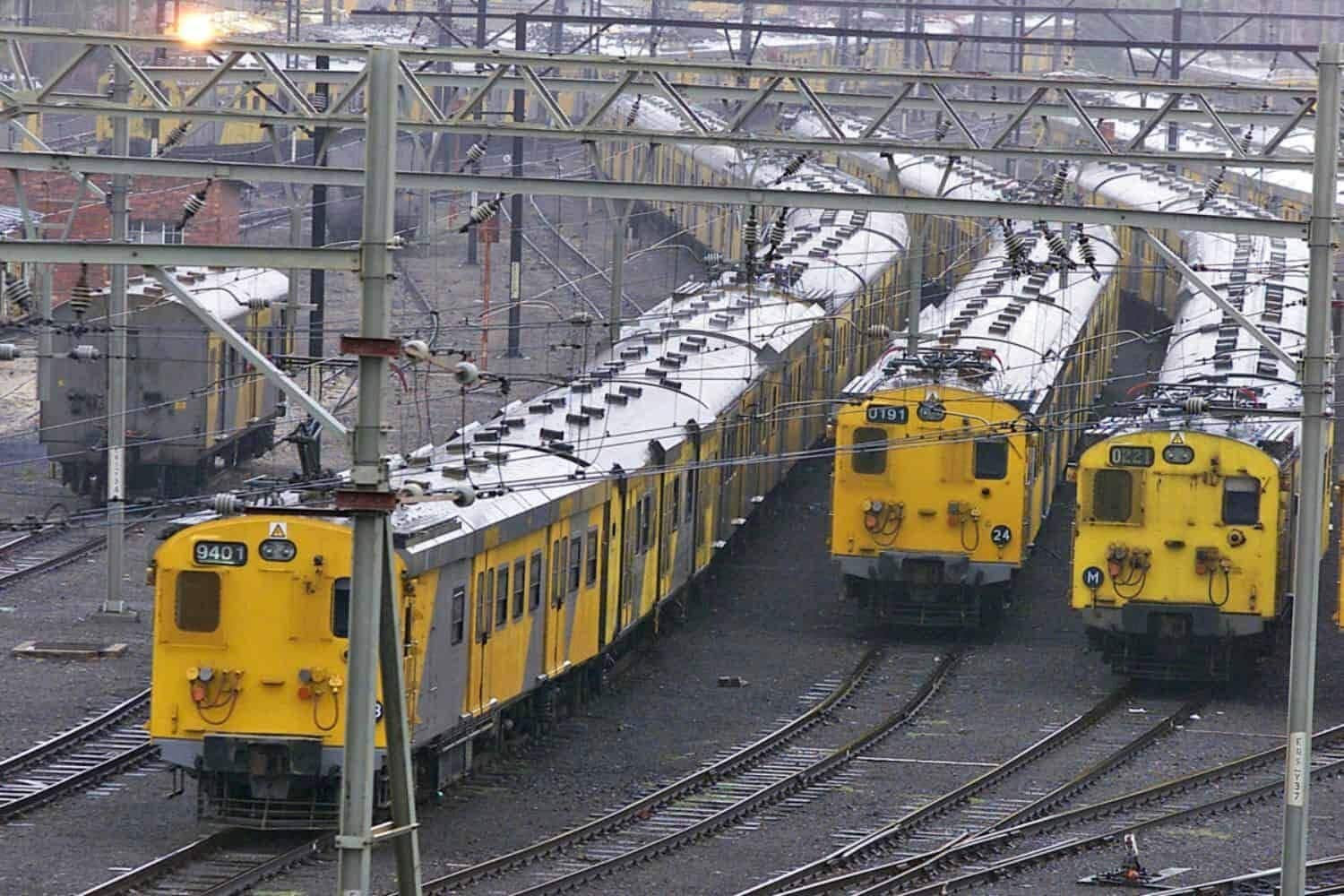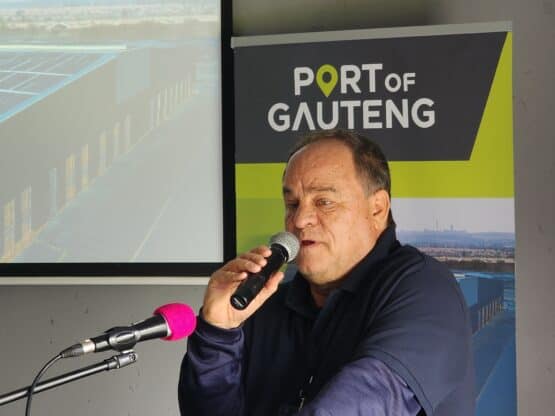It could also bury Joburg’s existing inland port at City Deep by offering faster container turnaround times.

The Port of Gauteng may be one of the first fruits of government’s decision to place Transnet’s rail infrastructure under independent management and open it up to private operators.
“We’re creating Africa’s most advanced inland trade gateway,” said port developer Francois Nortjé of NT55 at the launch of a White Paper on Tuesday, outlining the inland port’s potential to transform Gauteng’s economy.
“This facility represents our commitment to solving South Africa’s freight crisis while generating massive economic returns. The new facility, expected to get underway in 2027, will create about 50 000 permanent jobs, leading to sustainable economic growth for the province,” said Nortjé.

The Port of Gauteng should have been operational years ago, but Covid-19 interupted. Located on 1 400 hectares of land south of Johannesburg, at the junction of the N3, N12 and N17 highways, the planned port envisages a radical reordering of transport between Gauteng and Durban.
For one thing, it aims to remove roughly a third of the trucks that currently clog the N3 by shifting millions of containers onto rail.
The port facility will feature two 2.2-kilometre flat rail alignments designed for efficient container handling, along with integrated solar power, rainwater harvesting, and advanced recycling systems. Plans also include a world-class car terminal and container rail terminal, enabling fast, high-volume throughput and seamless train-to-truck transfers. All told, the port is expected to attract R50 billion in investment.
The establishment of the new inland port should benefit Transnet’s income statement, given its estimated loss of R1 billion per year on the Durban-Gauteng freight corridor between 2014 and 2019, rising to R3 billion during Covid-19 when train volumes fell from 80 to just 10 per day.
Transnet’s market share of container traffic on the route fell to 27% by 2012, falling further by 2014, as trucking companies unloaded containers in Durban to avoid costly empty returns.
Despite drastic cuts in rail charges, Transnet’s share of container tariff on the route never recovered above 16%. The evidence of this is visible along the N3, where trucks shuttle containers day and night.
Companies appear willing to pay far higher trucking charges for faster delivery to and from Durban. Given this stark reality, how will they be encouraged to shift to rail?
ALSO READ: Transnet moves ahead with plans to develop R2.5bn Gauteng port
Unsustainable traffic
The National Development Plan (NDP) projects container volumes on the Joburg-Durban route to grow from 2.8 million in 2024 to 20 million by 2030, although Transnet has settled on the more conservative 11.2 million containers per year as the ultimate target.
Anything approaching these volumes will turn the N3 into a Monday morning drive down Grayston Drive in Sandton. The highway simply cannot cope.
These volumes may appear unrealistic given the current sub-1% GDP growth, but could be achievable if growth accelerates. Sanral’s R28 billion upgrade of the N3/N2, due for completion in 2028, along with a project shaving 30km off Van Reenen’s Pass, will only add to the popularity of the highway. That means more road traffic unless rail can absorb the growth.
By truck, travel time from Port of Gauteng to Durban is eight hours over 550km. By rail, the distance is 690km and takes 21 hours. From City Deep, the travel time is 24 hours.
Given its location and projected container turnaround times, Port Gauteng could bury City Deep.
Without efficient rail integration, the N3 cannot sustain the anticipated traffic growth.
ALSO READ: R37.2bn set aside to steer Gauteng economy towards growth
Uncertain road ahead
The N3TC consortium operates the N3 highway, but its 30-year concession expires in 2029, at which point control will revert to Sanral. It remains unknown how much the consortium makes each year from toll collections on the N3, though it is likely substantial.
When the concession was granted in 1999, projections of truck traffic were far lower than the actual volumes seen today, meaning it is making far more revenue than originally envisaged – yet it refuses to open its books to public scrutiny on what is a key national asset.
Once reverted to state ownership, N3 tolls could be adjusted to a cost-recovery method, which would mean lower tolls and potentially even higher demand from trucking companies. The N3 would then need to be converted to a four-lane highway in each direction to cope with the expected increase in volumes.
More widespread use of Performance-Based Standards (PBS) vehicles – up to 30 metres in length and each capable of carrying two 12-metre containers – would vastly improve efficiency and capacity. These are now widely used in Australia, where they have led to fewer accidents, much lower fuel consumption, less road wear, and 20% to 50% increases in payloads.
The White Paper argues in favour of a balanced integration of PBS trucks and rail, with three-hour turnaround times at the planned car and rail terminals. PBS trucks on the N3 would be classified as abnormal loads, requiring permits, ensuring that their efficiency gains do not undermine rail entirely.
Tolls for PBS trucks would be increased to offset some of their cost advantages, while permit requirements would prevent them from diverting onto secondary routes.
“Reform of the N3TC would convert the concession into a hybrid model combining cost recovery with demand management, moving away from the current profit-driven mode,” says the White Paper.
Paul Nordengen, director at Heavy Vehicle Transport Technology Africa, adds: “The Port of Gauteng’s integration of PBS vehicles represents the most significant advancement in heavy vehicle transport efficiency we’ve seen in decades. It reduces truck movements by up to 40% and improves safety outcomes on our most critical trade corridor.”
The proposed Transport Economic Regulator would oversee the new toll structures to ensure balanced use of road and rail. During peak tourism seasons, PBS truck tolls could be increased to prioritise holiday traffic and improve road safety.
The Port of Gauteng wants to be formally recognised in the National Freight Logistics Strategy, as it aligns with government’s goal of diverting more traffic from road to rail. Achieving this will require reforming the N3TC profit model into a cost-recovery framework.
“Port of Gauteng changes everything. It provides the missing link that makes rail competitive again. With purpose-built rail alignments and future three-hour turnaround times at the container and car terminals, we can finally deliver the reliability that shippers demand,” says Mike Daniel, CEO of RailRunner South Africa.
This article was republished from Moneyweb. Read the original here.






